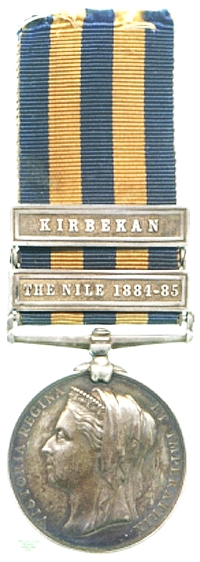
Obverse, a bust of Queen Victoria with veil

Reverse, the Sphinx on a pedestal facing left

Obverse, a bust of Queen Victoria with veil |

Reverse, the Sphinx on a pedestal facing left |
The serious weakening of Ottoman Egyptian power under foreign influence led to increasing attempts to shed Egyptian dominion in the Sudan, where in 1881 Sheikh Muhammad Ahmad ibn al-Sayyid 'Abd Allah was proclaimed as Mahdi (the legendary final redeemer of Islam). Several serious defeats of Egyptian forces in 1884 by his forces led to a concerted British campaign in defence of Egyptian claims, but control could not be recovered. The British withdrew their forces to Egypt and to Khartoum, where General Gordon defended the city whilst awaiting a relief column that, beset by Mahdist attacks, arrived too late.
One of the more unusual constituents of the relief expedition was a company of 384 Canadian voyageurs, expert raftsmen recruited to help get the whalers carrying the expedition up the treacherous rapids of the Nile. The irregular appearance of the Canadians was belied by their extraordinary labours with the boats, but most of them were allowed home after it was clear that Khartoum was lost. Foreman F. Delisle, one of the two commanders of the Caughnawaga Detachment appears to have been one of those who stayed, which allowed him to become of of only three of the voyageurs to participate in the capture of the Mahdist outpost at Kirbekan that earnt him the second bar to his medal. He was 50 years old at the time of the campaign.
Lester Watson purchased his medal at some point before 1928.
The Museum is grateful to Mr G. M. Stein for his researches and information on Foreman Delisle's part in the campaigns.